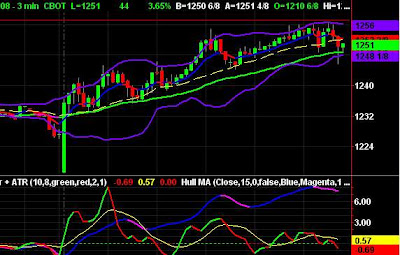This morning on CNBC's "Squawk Box", Joe Kernen, one of the co-anchors for the show, revealed his bias and stupidity when he suggested that congress should outlaw all margin futures trading, requiring all market participants to put up all cash to buy or sell in the futures markets. This would effectively ban futures trading for anyone but huge billion-dollar corporations that are self-funded, and drying up liquidity overnight.
He thought this would drive down commodity prices. What a stupid thing to say! One of the reasons that futures trading is effective for all traders is that the many participants in the market add liquidity. His absurd idea would completely dry up all liquidity in the futures markets. That liquidity benefits all participants, big and small, in the futures markets. It is the grease that keeps the futures markets vibrant and effective. That liquidity provides accurate and constant pricing discovery, which is absent in the rest of the world's $500 trillion derivatives pool that Warren Buffett describes as "financial weapons of mass destruction". It also provides a marketing mechanism for farmers year-round. Futures are the only liquid derivatives in the world, and Joe Kernen wants to destroy the only derivatives market in the world that works!
What will happen when Congress gets the same silly idea into their heads when other people on Wall Street begin to take up the banner and lobby for the same idiotic ideas? Or what if the Fed promotes that idea? Or some other lobbyist for an interest group that tries to persuade Congress that futures traders and hedge funds are the cause of inflation?
As I said, many of the traders in the futures markets are farmers, who market their products in the futures markets and plan to make delivery of their agriculture products. They buy and sell their products through futures, often with the intent to deliver the product at the end. If they couldn't sell their products, what would they do? Dump their product at the side of the road, the way they used to do in the mid 19th century before they could get honest prices, and before the Chicago Mercatile Exchange was created to provide the mechanism to accomplish that? What would America's agriculture pros do if only big corporations could get credit, but not America's farmers? These people are the heroes of our country, keeping our families fed and allowing the rest of us to live in more urban settings. Did Joe Kernen forget that?
Mr. Kernen thinks that liquidity provided by the Fed -- and backed by taxpayer dollars -- is a good thing. He loved the Fed bail-out and engineered JP Morgan rescue of Bear Stearns two weeks ago. He likes liquidity in the mortgage-backed securities market, and thinks that is a good thing. He even talks about the idea of the Fed and the taxpayers buying all the toxic mortgage soup his friends created. He also thinks that liquidity in the stock market is a good thing. He didn't suggest eliminating margin use in the owning of equities, did he? But he has the asinine notion that eliminating liquidity in the futures market would force prices down and eliminate inflation. It wouldn't! It would simply dry up pricing accuracy for farmers and add fuel to the toxicity in the financial mess his buddies on Wall Street created. It would very likely force prices even higher as farmers reduce their yields when they can't get a fair shake.
This absurd suggestion not only reveals his gross bias for equities. It also reveals how stupid the guy is regarding the laws that govern the financial markets, and what makes them work.
Futures are the only derivatives form that most people can participate in. They are also the only derivatives market in the world that is not only liquid, but has deep liquidity without constant government intervention that disrupts the markets. In 150 years, no futures broker has ever gone belly up in the United States and left its clients holding the bag! Not once! Can Joe's Wall Street buddies say the same? How many financial crises have been created by his buddies, including the current one? Perhaps that's why the futures market works, Joe!
The whole credit crisis and mortgage melt-down has occurred because his buddies on Wall Street, for whom he has such a love affair and bias, created derivatives instruments that aren't liquid and therefore can't be traded! They can't buy or sell them, and they can't price them. They just sit there like rotting refuse on the books of companies and pension funds around the world. And now Joe Kernen cheerleads while the Fed and the taxpayer is on the hook to rescue all that toxic financial waste. No one knows what all that toxic paper is worth. These non-liquid derivatives are the cause of the entire mortgage melt-down, the plunge in the stock market, and the current recession, and yet we don't hear Joe Kernen ranting against them, do we?
Why doesn't Mr. Kernen go back to studying biology? At least that's something he understands!
Perhaps we who work in the financial markets should express our displeasure to CNBC, either by email, or by bolting to the Fox Business Network or Bloomberg. Perhaps that would teach Joe Kernen a thing or two!
 Daily Chart
Daily Chart
































